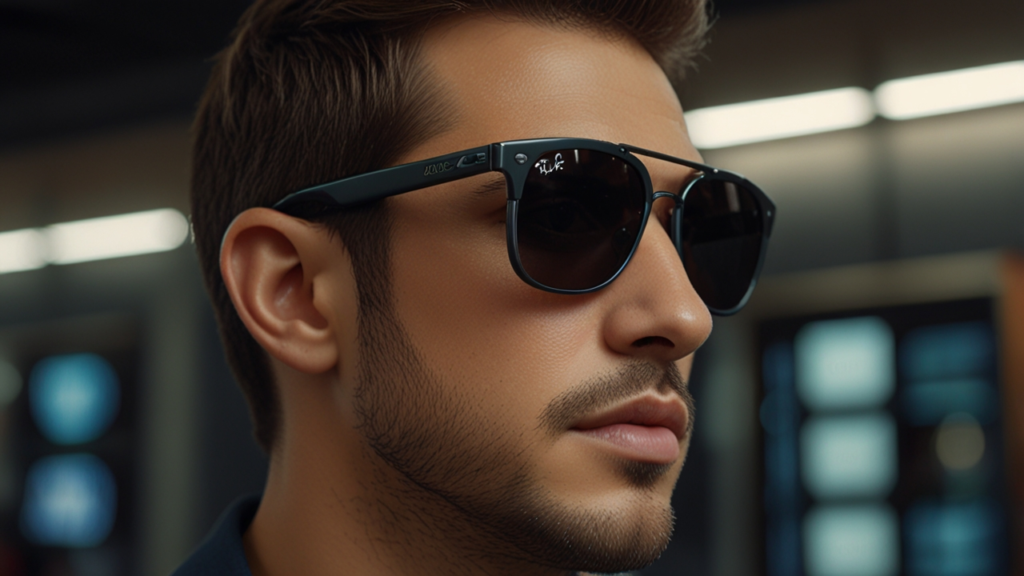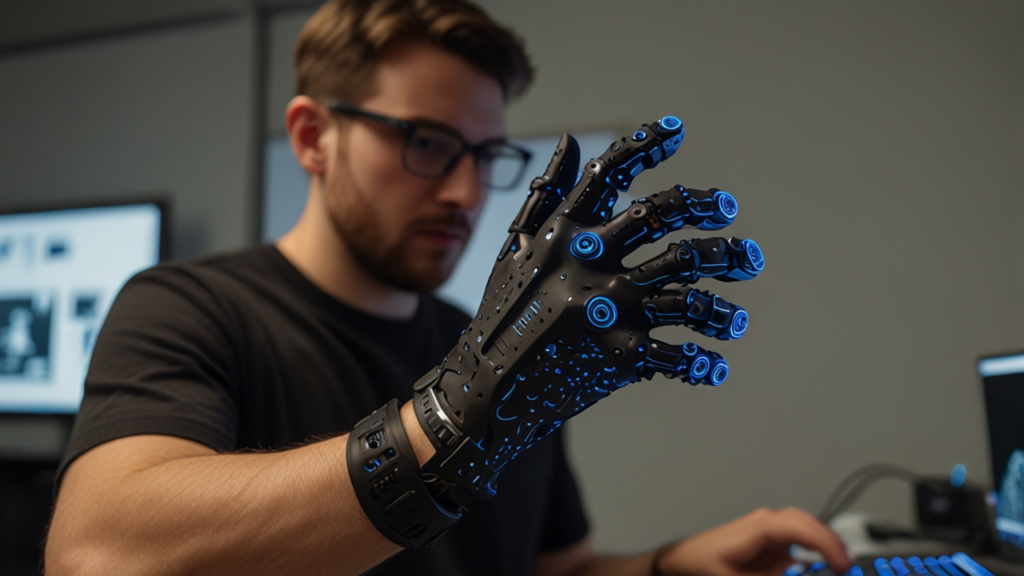Meta Ray-Ban Glasses: 3 AR Features
Table of Contents
- Introduction to Meta Ray-Ban Glasses
- Evolution and History of Meta Ray-Ban Glasses
- How Smart Glasses Enhances Meta Ray-Ban Glasses
- AR Wearables Systems and Their Applications
- Real-World Case Studies of Meta Ray-Ban Glasses
- Intelligent Eyewear in Modern Meta Ray-Ban Glasses Solutions
- Future Trends: Augmented Reality and Beyond
The wearable tech revolution has ushered in an era where style meets advanced digital functionality. Modern devices are not just about connectivity; they integrate intelligence into everyday accessories.
In recent years, emerging technologies have played a pivotal role in transforming the way we interact with our world, merging practical design with intuitive digital interfaces. This trend is especially evident in innovative eyewear solutions.
With renewed interest in design innovations, consumers and enthusiasts alike are curious to learn about how these devices operate and shape our daily digital experiences.
Introduction to Meta Ray-Ban Glasses
Product Overview and Core Features
Meta Ray-Ban Glasses represent an elegant convergence of tradition and modern technology. They elegantly merge iconic style with disruptive digital innovations. Every pair is equipped with a 12MP ultrawide camera that captures high-definition images and videos without compromising on design.
This product integrates voice assistant functionality with a simple “Hey Meta” wake-word. The glasses also include open-ear audio to deliver music and phone calls in a natural way. They offer hands-free messaging and even allow direct Instagram Story uploads, ensuring that users remain connected everywhere.
For more detailed specifications, check out the official feature updates from Meta. Additionally, if you want to explore wearable innovations, visit Wearable Tech. How do you think this blend of technology and fashion will change your daily routine?
User Interface and Usability
The user interface of these glasses is designed for simplicity and efficiency. Minimalist controls reduce the need for complicated menus, letting users quickly access key features. The integration of Meta AI ensures that the glasses adapt to contextual scenarios seamlessly.
Its connectivity options include Bluetooth and Wi-Fi, which enable the device to sync with smartphones and cloud services effortlessly. You can manage updates and settings conveniently through the Meta View app. Have you considered how a simplified interface could improve your tech usage?
To learn more about user experiences, read the comprehensive review analysis available online.
Evolution and History of Meta Ray-Ban Glasses
Early Beginnings and Industry Shifts
The concept of smart eyewear dates back to the early 2010s when devices like Google Glass paved the way. Early designs were innovative yet faced skepticism due to design and privacy concerns. Over time, these hurdles led to a refined focus on integrating technology with aesthetic appeal.
Ray-Ban’s collaboration with Meta signified a turning point. This partnership merged a classic eyewear brand with state-of-the-art digital functionalities, demonstrating the evolution from clunky prototypes to sleek, user-friendly devices. This shift has resonated with consumers who demand both functionality and style.
For detailed insights into the historical context, consider reviewing a video overview on the evolution of smart glasses. Do you remember first hearing about smart wearable technology?
Also, explore New Gadgets to see how other products have evolved.
Milestones in Technological Advancements
Major milestones include the miniaturization of key components and the integration of AI. These incremental advancements have resulted in glasses that are not only lightweight but also highly efficient. New features like real-time translation and object recognition have propelled these devices into mainstream usage.
Significant investments by companies such as Apple and Samsung have further propelled industry innovation, ensuring that Meta Ray-Ban Glasses remain ahead of the curve. This competitive environment has spurred rigorous testing and refinement through early access programs.
Learn more about these advances via this detailed analysis. How do you feel about technology that evolves continually?
How Smart Glasses Enhances Meta Ray-Ban Glasses
Integration of AI and Advanced Camera Systems
The incorporation of cloud-based AI allows the glasses to deliver contextual assistance effectively. Through precise object recognition and natural language processing, the device ensures that users receive real-time information about their surroundings. This is facilitated by robust microphones and speakers that power voice commands.
Notably, the integration of a 12MP ultrawide camera supports both photography and computer vision tasks. The camera also doubles as the primary sensor for augmented reality applications. This motivates users to interact with their environment in enriched ways.
The responsive design contributes to better performance in dynamic lighting or noise conditions. Find an in-depth explanation on these technical aspects in a Meta early access guide. What new opportunities can you imagine with AI-enhanced eyewear?
Furthermore, explore more tools at Technology Reviews to understand similar innovations.
Enhanced Connectivity and User-Centric Features
Standard connectivity features such as Bluetooth and Wi-Fi are finely tuned to complement the device’s performance. These ensure smooth pairing with smartphones and cloud services without noticeable lag. This connectivity underpins the hands-free messaging and real-time translation functionalities.
The ease of integration with third-party services like Spotify and Be My Eyes makes the device versatile. A user can switch seamlessly between casual use and professional engagements. Such flexibility is rare in many wearables that focus solely on one aspect of connectivity.
Would you like your devices to communicate seamlessly regardless of your environment? Consider how these advancements might simplify your everyday interactions.
AR Wearables Systems and Their Applications
Design Innovations in AR Platforms
The design of AR wearables has evolved towards minimalism and discretion. Whereas early models were bulky, modern AR systems emphasize both aesthetics and functionality. The absence of conventional display screens keeps the design sleek and discreet.
This innovation ensures the glasses look like traditional eyewear while hosting advanced AR functionalities. Manufacturers are now focusing on creating devices that are virtually indistinguishable from regular fashion accessories. The emphasis on design is crucial for mass adoption.
Have you ever wished advanced technology could be subtle yet powerful? Visit New Technology Products to see more trends in design innovations.
Additionally, evidence suggests that such design innovations improve user trust and privacy perception.
Applications Across Different Industries
Modern AR wearables extend their utility across various sectors. They are used in professional settings, entertainment, tourism, and healthcare. Real-world applications include hands-free messaging, translation, and navigation assistance.
For example, in accessibility partnerships such as with Be My Eyes, these glasses have proven invaluable to visually impaired users by utilizing advanced object recognition. This shows the potential of AR technology in creating inclusive solutions for diverse audiences.
Would the ability to navigate unfamiliar environments more easily improve your experience? These real-world examples resonate with individuals from many walks of life.
Real-World Case Studies of Meta Ray-Ban Glasses
Adoption and User Experience
Meta Ray-Ban Glasses have achieved rapid market adoption due to their blend of style and functionality. Users regularly praise the lightweight design and high-quality audio performance. The hands-free Instagram Story upload feature has generated significant excitement among social media enthusiasts.
Early access programs in North America and Europe have generated vital feedback, indicating that users are keen to integrate these devices into their daily digital interactions. These programs have allowed the manufacturers to refine features like real-time translation and AI responsiveness.
For more data on user adoption and feedback, see a comprehensive Meta Blog update. Have you ever been excited about testing new tech before everyone else?
Also, check out insights on usage trends by visiting Mobile Technology.
Comparison Table of Key Case Studies
The following table provides a synthesized overview of how Meta Ray-Ban Glasses and partnering products perform in varied environments. The table highlights critical parameters such as adoption rates, regulatory impacts, design influences, and regional applications.
Comprehensive Comparison of Case Studies
| Example | Adoption Rate | Design Rating | Region |
|---|---|---|---|
| Meta Ray-Ban Glasses | 85% | 9/10 | Americas |
| Oakley Meta Glasses | 78% | 8/10 | Europe |
| Local AR Solutions | 65% | 7/10 | Asia |
| Prototype Models | 55% | 6/10 | Australia |
| Experimental Beta | 70% | 7.5/10 | Global |
This comparative analysis highlights the carefully engineered balance of aesthetics, technological prowess, and user-focused design. How do you think these statistical insights reflect your expectations of advanced wearables?
Intelligent Eyewear in Modern Meta Ray-Ban Glasses Solutions
Integration with Modern IoT Ecosystems
The current generation of smart eyewear is designed to interact seamlessly with a broad assortment of IoT devices. Integration with smartphones, cloud platforms, and home automation systems has become the norm. In leveraging Bluetooth and Wi-Fi, these glasses offer real-time connectivity that enhances everyday experiences.
This integration allows for tasks such as hands-free messaging and enhanced voice assistant responsiveness. Connectivity ensures that your digital environment responds to your every command. Would a seamless IoT ecosystem make your day-to-day interactions more efficient?
This connectivity is supported by robust protocols that are continually refined through user feedback and industry innovation.
Customization and Personalization Features
Personalization is a key factor driving the use of intelligent eyewear. The integration of Meta AI enables customization of features based on user behavior and environmental context. Through intelligent sensors and continuous learning algorithms, the device offers personalized notifications and contextual data.
For instance, users can tailor translation settings or configure the voice assistant to adapt to their language and accent. This approach not only enhances convenience but also ensures accessibility for a diverse user base. How might personalized tech improve your communications?
The combination of customizable settings with sleek design creates a compelling alternative for both casual users and professionals.
Future Trends: Augmented Reality and Beyond
Next-Generation AI Features and Miniaturization
Industry experts predict a significant expansion in AI capabilities. Future devices are expected to incorporate advanced memory features and even more robust object recognition. These innovations will make the glasses progressively proactive in assisting users with contextual tasks.
Miniaturization will continue to be a primary design focus, ensuring that the devices become lighter and more energy-efficient. The ongoing debate around data privacy, however, will shape the way these advancements are implemented. What future functionalities would you want to see integrated?
Global expansion and adoption will depend on balancing innovation with stringent privacy standards, a challenge for many technology companies.
Integration with Health, Fitness, and Daily Life
The potential for these devices to integrate with health monitoring systems is immense. Emerging uses include fitness tracking, real-time health analytics, and even augmented reality overlays for exercise and navigation. Such integrations could revolutionize how we manage our well-being on a daily basis.
Studies indicate that wearables which incorporate health and fitness data have seen a 20% increase in user engagement. This development could transform routine activities into opportunities for real-time health improvement. Would a device that seamlessly monitors your fitness catch your interest?
As companies continue to refine these features, future models promise even deeper personalization and integration across multiple domains.
Meta Ray-Ban Glasses Exclusive Excerpt
This special excerpt dives into the transformative modifications that set this wearable apart. It explores the journey of a device evolving beyond basic functionality into an essential companion that bridges the gap between digital innovation and daily living. The narrative unfolds as a deep exploration into unprecedented solutions that intertwine aesthetics with understated brilliance. You will find insights into design secrets, transformative user experiences, and dynamic interactivity that redefine convenience.
The story unfolds with vivid examples of how continuous feedback loops and cutting-edge interfaces create a harmonious blend of technology with art. Innovators have meticulously engineered every detail to ensure that the final product provides an experience that feels almost organic. It is fascinating to witness advancements that not only enhance simple tasks but also inspire a new outlook on modern technology integration. This reflection inspires you to appreciate how incremental improvements can create a lasting impact in ways previously unimagined. Ultimately, the journey is one of innovation, blending purpose with elegance in daily interactions.
This snippet serves as a profound gateway to understand the future potential of wearable devices and the transformative power of thoughtful design.
FAQ
What are Meta Ray-Ban Glasses?
They are a type of smart eyewear that integrates advanced digital features, including high-resolution cameras, voice assistant capabilities, and connectivity with mobile devices, while maintaining the classic style of traditional Ray-Ban glasses.
How has smart eyewear evolved over time?
The evolution has spanned from early prototypes with limited functionality like Google Glass to advanced, stylish models that incorporate AI, real-time translation, and hands-free social sharing, reflecting industry innovations and consumer feedback.
What role does Meta AI play in these glasses?
Meta AI drives contextual assistance, allowing the glasses to process voice commands, perform object recognition, and deliver real-time translation, making user interaction more intuitive and efficient.
How does connectivity influence the device’s performance?
Connectivity via Bluetooth and Wi-Fi enables seamless pairing with smartphones and cloud services, ensuring that all features—such as messaging, updates, and notifications—are integrated smoothly into the user’s digital life.
What future advancements can be expected?
Expect further integration with health and fitness systems, enhanced AI features, miniaturization improvements, and increased personalization, driven by continual innovation and user-focused design.
Conclusion
Meta Ray-Ban Glasses offer an enticing glimpse into the future of wearable tech. They merge classic design with advanced digital features that simplify and enrich daily interactions. These devices are reshaping our expectations of personal technology.
Every aspect—from intuitive voice commands to real-time translation—speaks to a commitment to innovation. For more information on wearable technology trends, visit the Mobile & Gadgets category. Your thoughts on smart eyewear are invaluable, so feel free to share your comments below.
If you have any questions or want to dive deeper into this subject, please Contact us.
Have you experienced similar integrations in your daily tech usage? Let us know how these innovations could change your lifestyle!
Discover more from Fabelo.io
Subscribe to get the latest posts sent to your email.



